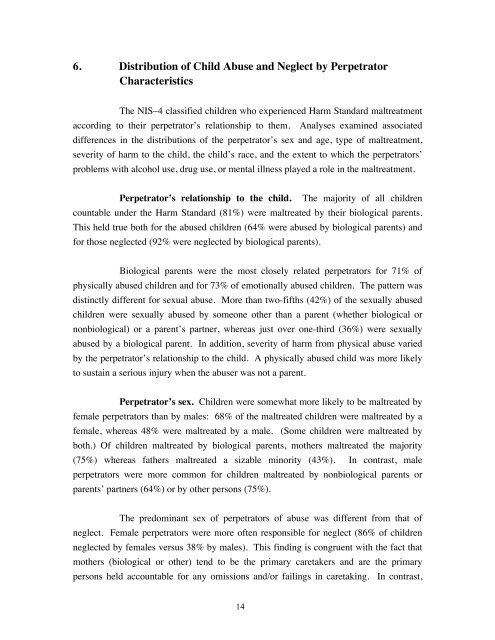National Incidence Study of Child Abuse and ... - Children's Central
National Incidence Study of Child Abuse and ... - Children's Central
National Incidence Study of Child Abuse and ... - Children's Central
- No tags were found...
Create successful ePaper yourself
Turn your PDF publications into a flip-book with our unique Google optimized e-Paper software.
6. Distribution <strong>of</strong> <strong>Child</strong> <strong>Abuse</strong> <strong>and</strong> Neglect by PerpetratorCharacteristicsThe NIS–4 classified children who experienced Harm St<strong>and</strong>ard maltreatmentaccording to their perpetrator’s relationship to them. Analyses examined associateddifferences in the distributions <strong>of</strong> the perpetrator’s sex <strong>and</strong> age, type <strong>of</strong> maltreatment,severity <strong>of</strong> harm to the child, the child’s race, <strong>and</strong> the extent to which the perpetrators’problems with alcohol use, drug use, or mental illness played a role in the maltreatment.Perpetrator’s relationship to the child. The majority <strong>of</strong> all childrencountable under the Harm St<strong>and</strong>ard (81%) were maltreated by their biological parents.This held true both for the abused children (64% were abused by biological parents) <strong>and</strong>for those neglected (92% were neglected by biological parents).Biological parents were the most closely related perpetrators for 71% <strong>of</strong>physically abused children <strong>and</strong> for 73% <strong>of</strong> emotionally abused children. The pattern wasdistinctly different for sexual abuse. More than two-fifths (42%) <strong>of</strong> the sexually abusedchildren were sexually abused by someone other than a parent (whether biological ornonbiological) or a parent’s partner, whereas just over one-third (36%) were sexuallyabused by a biological parent. In addition, severity <strong>of</strong> harm from physical abuse variedby the perpetrator’s relationship to the child. A physically abused child was more likelyto sustain a serious injury when the abuser was not a parent.Perpetrator’s sex. <strong>Child</strong>ren were somewhat more likely to be maltreated byfemale perpetrators than by males: 68% <strong>of</strong> the maltreated children were maltreated by afemale, whereas 48% were maltreated by a male. (Some children were maltreated byboth.) Of children maltreated by biological parents, mothers maltreated the majority(75%) whereas fathers maltreated a sizable minority (43%). In contrast, maleperpetrators were more common for children maltreated by nonbiological parents orparents’ partners (64%) or by other persons (75%).The predominant sex <strong>of</strong> perpetrators <strong>of</strong> abuse was different from that <strong>of</strong>neglect. Female perpetrators were more <strong>of</strong>ten responsible for neglect (86% <strong>of</strong> childrenneglected by females versus 38% by males). This finding is congruent with the fact thatmothers (biological or other) tend to be the primary caretakers <strong>and</strong> are the primarypersons held accountable for any omissions <strong>and</strong>/or failings in caretaking. In contrast,14
















